
Unfortunately, water ingress is a very common problem. Due to water leaks, there are thousands of homes across Australia left with a range of issues from major extensive and costly structural damage to constant damp and proliferation of mould.
by Paul Evans
Immediate Past President – Australian Institute of Waterproofing (AIW) 2016-2022
Managing/Director Findlay- Evans Waterproofing
October 12, 2023.
For some Australians, the dream of owning their own home is becoming a nightmare as they deal with the ramifications of poor waterproofing.
Details
Unfortunately, water ingress is a very common problem. Due to water leaks, there are thousands of homes across Australia left with a range of issues from major extensive and costly structural damage to constant damp and proliferation of mould.
Waterproofing problems are complex and often not obvious. As a waterproofing consultant and remedial builder, I have witnessed multiple cases of water ingress caused by design concept and building defects, rather than the waterproofing method or materials.
Case Study – Balcony Structure Severely Compromised Due to Water Ingress
With time, water damage can be catastrophic but remain silent and unseen until visual evidence is showing. By this stage, rectification can be costly.
This case study began from an investigation of a leaking balcony for a private townhouse in the suburb of Camberwell in Melbourne’s eastern suburbs. Construction was seventeen years ago.
Signs of black mould were forming within the ceiling spaces below the balcony. This needed to be treated as was a health hazard to all occupants.
What started out looking like a minor defect due to balcony leaks, once opened, evolved into a major structural re-build.
Consistent and extensive water damage over many years had evolved into the risk of partial collapse to a family’s home.
(See images below clearly demonstrating the devastating effects of water ingress to the building. Please refer to destruction of the main side beam supporting the building’s first floor.)
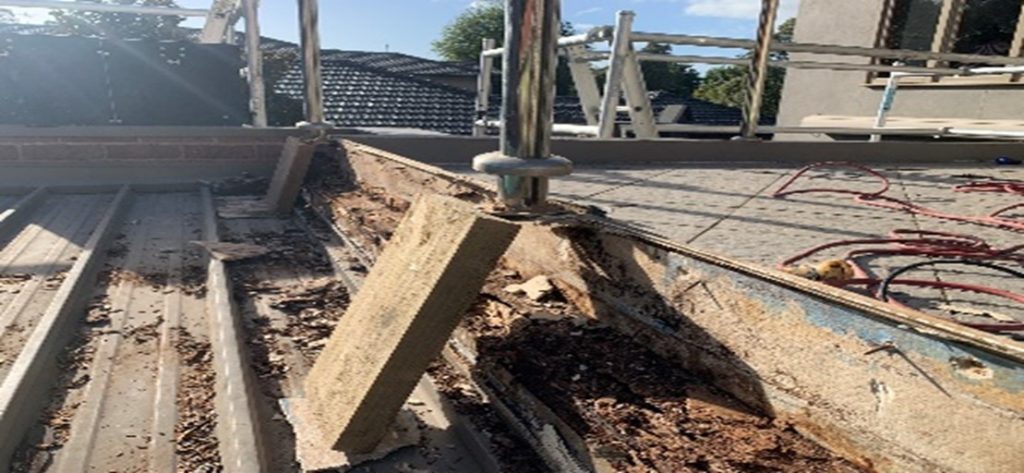
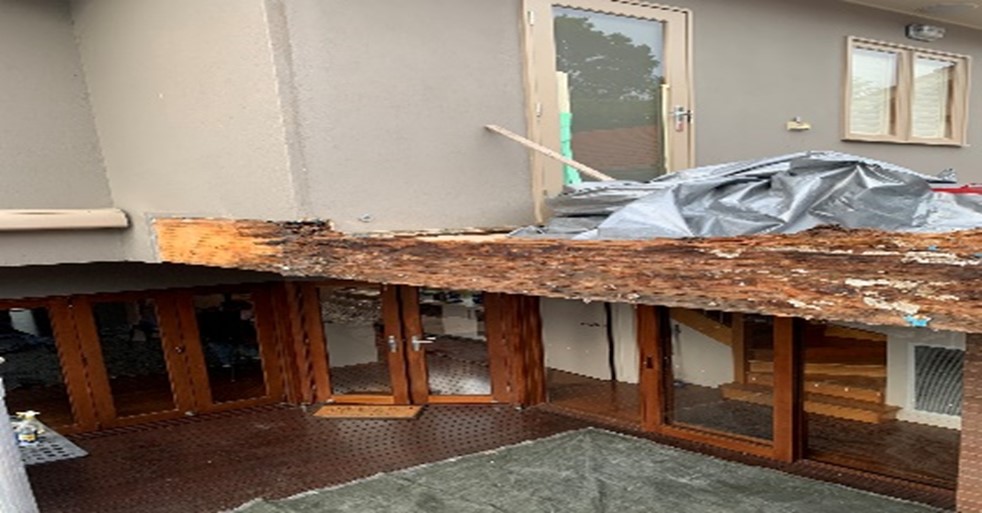
The design and method used by the original builder was grossly inadequate to manage water and prevent water intrusion. Astoundingly, the home’s design relied solely on acrylic render as the waterproofing barrier.
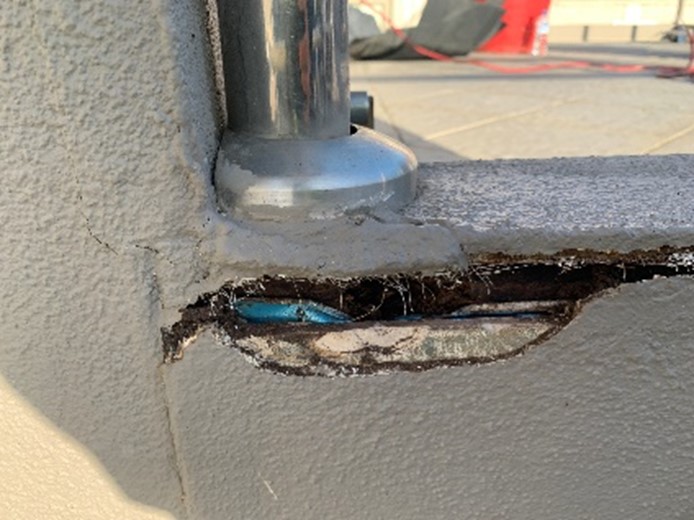
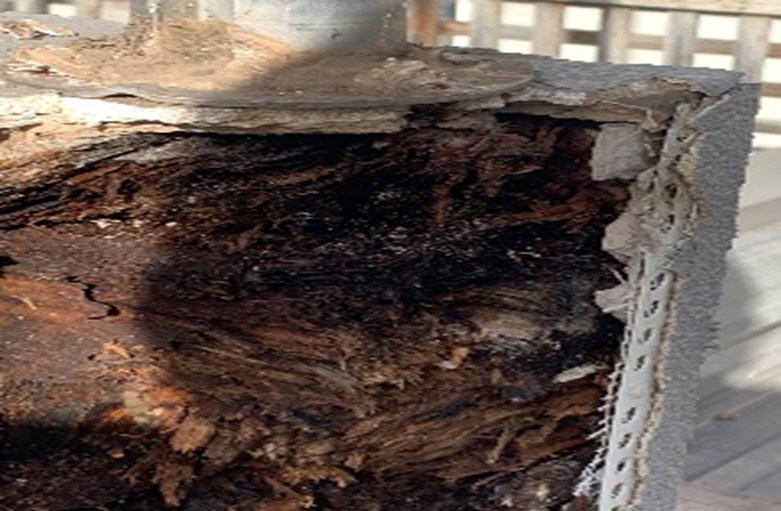
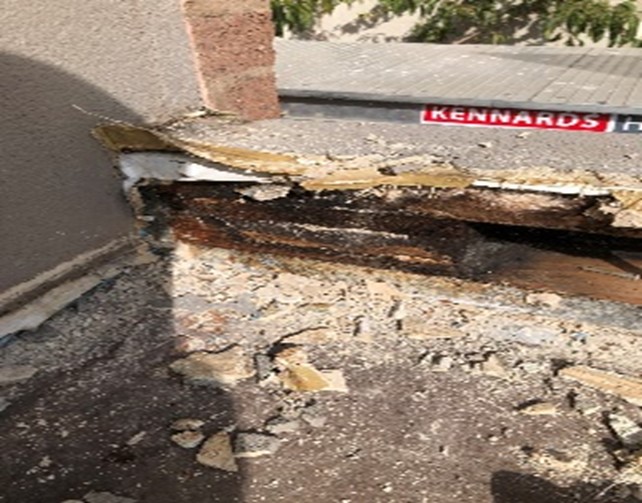
Compounding this even further, the balcony balustrade was fixed directly through the acrylic render. This allowed another source of water ingress via fixing screws.
Photos below show the dangerous and hazardous structural situation. These unsuspecting homeowners were living in a structural unsound building.
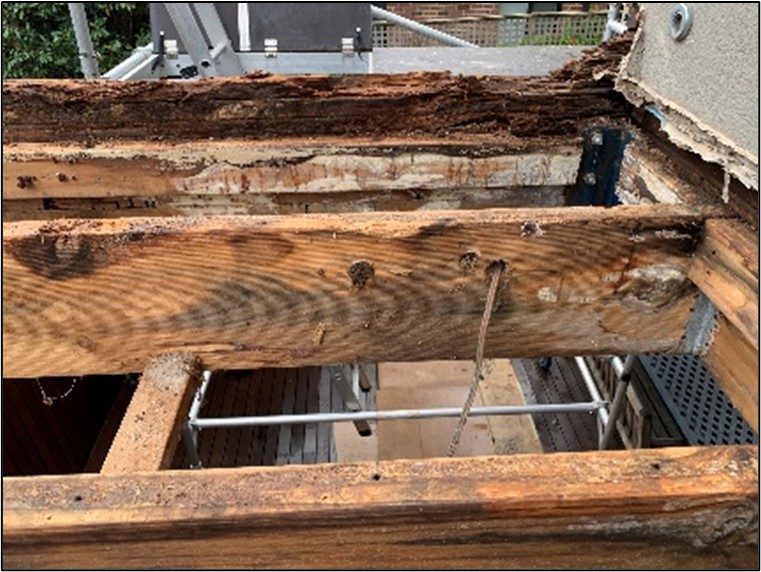
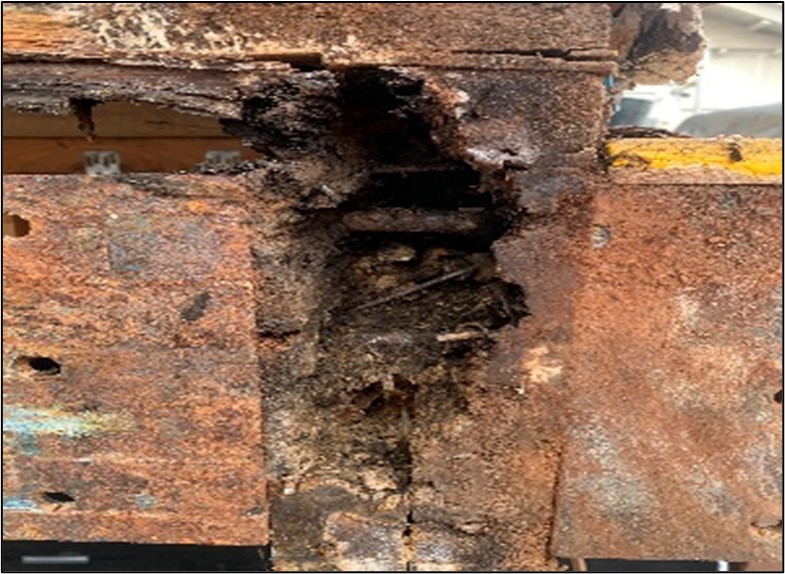
Water Damage to Homes Can Be Prevented
As well as best practice waterproofing methodology, there are multiple construction practices that need attention to ensure a building is made watertight.
Water ingress can be prevented by addressing some common construction defects such as:
1. Poorly installed or damaged roof covering
One of the most common causes of water ingress is a poorly installed or damaged roof covering. If the roof covering is not installed correctly, or if it is damaged, water can penetrate through the roof and enter the building. This can cause structural damage, damp, and mould. To prevent this, roof coverings need to be correctly installed and should be cleaned and maintained on a regular basis.
2. Poorly designed or installed gutters and downpipes
Another common cause of water ingress is poorly designed or installed gutters and downpipes. If the gutters and downpipes are not designed or installed correctly, water can overflow from the gutters and enter the building. This can cause damp and mould, as well as damage to the building’s foundation. To prevent this, it is important to ensure that gutters and downpipes are designed and installed correctly and are regularly maintained.
3. Poorly designed or installed flashings
Flashing is a material (zincalum or Colourbond, aluminium, etc) that is used to prevent water from entering a building around openings such as windows, doors, and vents. If the flashing is poorly designed or installed, water can penetrate the building and cause damage. To prevent this, it is important to ensure that flashing is designed and installed correctly and is regularly inspected and maintained.
4. Cracks in the building’s structure
Cracks in the building’s structure can also cause water ingress. If there are cracks in the building’s structure, water can penetrate the building and cause damage. This can also result in damp and mould. To prevent this, it is important to ensure that the building’s structure is regularly inspected, and any cracks are repaired as soon as possible.
5. Poorly designed or installed cladding
Cladding is a material that is used to cover the exterior of a building. If the cladding is poorly designed or installed, water can penetrate the building and cause damage. This can also result in damp and mould. To prevent this, it is important to ensure that cladding is designed, fire resistant and installed correctly, and is regularly maintained.
6. Poorly installed or damaged windows and doors
Windows and doors are also common areas where water can enter a building. If the windows and doors are poorly installed or damaged, water can penetrate the building and cause damage. This can also result in damp and mould. To prevent this, it is important to ensure that windows and doors are installed correctly and are regularly maintained. We often see cement sheet abutting a window frame and just a sealant installed (at best) to prevent water ingress. This sealant breaks down over a few years and cracks or delaminates, allowing water ingress.
As a waterproofing consultant and remedial builder for more than four decades, I would strongly recommend that homeowners and apartment managers regularly inspect balconies, roofs and basements or have their buildings inspected by appropriate professionals. Addressing water ingress issues as early and as soon as possible goes a long way to mitigating the costly future problems.
Please note, inspections to assess and prevent water ingress require a holistic approach. I have witnessed far too many buildings that are seen to “conform” to the plumbing code for instance, only to find water leaks caused by rain/wind driven under roof flashings that would be deemed “compliant” on visual (non-invasive) inspection.
Basements Need to Overcome Unique Water Management Challenges
Underground basements have unique waterproofing challenges due to their below ground location and the environment in which they exist.
Habitable below ground rooms are a common design option for many buildings. However water leaks in these situations can be a nightmare to rectify.
The potential for basement water leaks can be via various routes:
-
- cracks/gaps in the basement walls or floor
- poorly designed/installed waterproofing
- poorly installed drainage systems.
Unfortunately, it is not just water itself that is the challenge with basements. Another common problem is poor ventilation. This can lead to a build-up of moisture and pollutants in the underground air. Potentially, this can cause health problems for occupants and damage to the building’s structure and finishes.
Each below ground project is unique and requires careful consideration in respect to site conditions, building materials, and environmental factors. Basement waterproofing is not a “one-size-fits-all’ scenario. Waterproofing design and consultation for each project helps to ensure underground spaces are built watertight to a high standard and perform as required over time.
To address these challenges, it is important to work with experienced professionals who have expertise in underground waterproofing construction. In this way, potential issues are flagged early in design and appropriate solutions can be devised. Once again, regular maintenance and inspection help to ensure that issues are addressed before evolving into major problems.
However, one of the biggest challenges Australia faces is that there is no below ground waterproofing Australian Standard for basement design or construction.
Builders & Lack of Waterproofing Awareness
Although waterproofing is an essential part of building, many builders do not receive appropriate waterproofing training and have little or only basic knowledge when it comes to waterproofing. This leads to many of the aforementioned problems.
Why is this the case? And what can be done?
I suspect one reason is that waterproofing installation is viewed as a minor and not very skillful part of construction.
Builders need to focus on building with structural integrity (you hope), create aesthetic appeal, and improve energy efficiency. These values are viewed as critical and important by designers, clients and stakeholders.
Results of poor waterproofing maybe seventeen years down the track, as per case study above. As a result, waterproofing is more often given less attention or emphasis. This leads to gaps in knowledge and oversights.
Installing a waterproof membrane may appear a simple task. However, there is complexity and a technical aspect to the process. Waterproofing requires a deep understanding of building materials, design principles, environmental factors, as well as specialized skills and techniques for installation and maintenance. Builders may not appreciate the relevant subtleties required to make structures watertight.
The designers and builders often are not even aware of the consequences of their inappropriate design or inadequate waterproofing. The devastating results of their leaking buildings are future problems – to be dealt with by others. They create buildings where water damage leads to decay and deterioration of building materials, buildings that are conducive to mould growth and indoor air quality issues. Buildings that cause health problems for occupants, property devalues and in extreme cases catastrophic structural damage putting occupants at risk of injury or worse.
Waterproofing Education for Construction
To address these issues, it is important to prioritize waterproofing education and training for builders and other construction professionals. This should include formal courses and certifications, as well as practical on-the-job training and mentoring from experienced professionals.
Builders should also be encouraged to seek out information and resources on waterproofing best practices and stay up to date with the latest developments in the field. Being the immediate past President of the Australian Institute of Waterproofing (AIW), I recommend the advice by the AIW in their regular updates published via a quarterly newsletter.
Construction professionals, you should consider becoming a member to gain access to this information. Go to: www.waterpoof.org.au
In addition to education and training, technical and regulatory measures can help to improve waterproofing outcomes. There are also various building codes and standards that provide guidance on waterproofing requirements and best practices, which can help to ensure that builders are meeting minimum standards and delivering high-quality results.
These include, and certainly not limited to:
-
- use of high-quality materials and installation techniques
- incorporation of effective drainage systems and moisture barriers
- implementation of regular maintenance and inspection programs.
Communication has a critical role for collaboration in achieving effective waterproofing outcomes. Builders should work closely with other stakeholders such as architects, engineers, and in particular – waterproofing consultants to ensure that all aspects of the build design and the construction process are aligned with managing water and the waterproofing goals.
Clear and concise communication and documentation can help to ensure that everyone is on the same page and critical or challenging issues are identified and addressed early on.
Finally, it is important to recognize that education and training in waterproofing is not a one-time event, but an ongoing process of learning and improvement.
Builders should be encouraged to seek out opportunities for professional development and to share their knowledge and experience with others. By prioritizing education and collaboration, we can help to ensure that builders have the skills and knowledge they need to deliver high-quality, waterproofed buildings that are safe and healthy for occupants.